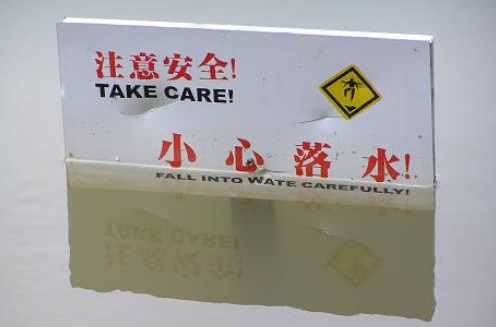Safe Water Entry and Exit
Most training sessions call for swimmers to enter the water off the pool deck as well as from a height of 3 meters. This lesson shows you how.
Entry for unknown Conditions
Slide-in entry appropriate for unknown water.
Entries with Rescue Aids
At least 2 different entries with different rescue aids.
Dives
Shallow head-first dives.
Always dive into deep water, never into shallow water.
Hitting the floor can break your neck.
Shallow Water
Always enter shallow water in a safe manner,
feet first. Don't dive in.
Entries from a Height
Compact jump into deep water.
Surface Dives
Foot-first and head-first surface dive to a maximum depth of 2m
Ready Position
Stay in one place for one minute, either floating or treading water.
Self-Rescue
Simulate self-rescue for ice, moving water and swamped or capsized boat
Wading Entry
Wading into shallow water is the best method for unknown conditions.
Carefully feel the way forward with your feet. Make sure you wear robust footwear incase you step onto something with sharp edges.
Move forward until you are in chest deep water and begin to swim.
Slide-in Entry
This simulates entry into unknown water with a steep edge.
You may not know what is underwater, so be careful. Slide in slowly, feel the ground with your feet.
Then wade into chest deep water and begin to swim.
Step-off Entry
For shallow-water entry off the deck, step off the edge into the water with your knees flexed. This ensures a soft landing on the pool floor.
Be prepared to absorb the impact when hitting the bottom of the pool.
Air bubbles in your clothes will give you a bit of initial bouyancy, but not for long as the air escapes quickly.
Now lean forward and start to swim.
Stride Entry / Straddle Jump
For deep-water entry off the deck, leap off the edge into the water with your body leaning forward, the head up, the legs spread in a stride position (one forward, the other back), and the arms extended out to slap the water and reduce the depth you go under. Kick your legs or use breaststroke like movements to surface again.
This jump position keeps the head above water and allows you to maintain visibility. The water should be at least 1.5 meters deep.
If you're good at this then your head should remain out of the water.
You can test this by wearing a dry hoodie with the hood up.
After your jump the hood should still be somewhat dry.
Dive Entry
Only head dive into known water, never into unknown conditions. The dive entry is often used for competitive swimming, but can also be good fun for survival swimming. You could organise a fully clothed relay race which can be quite a challenge.
Shallow Dive Entry
The shallow dive is used where you expect shallow water, as you just glide across the surface.
However, sharp objects below the surface may still hit you.
Use it wisely.
Keep your head out of the water.
High-Level Entry
Jump in feet first from a height of 3 meters (10ft) using the high-level-entry jump position; stabilise, and swim the length of the pool to the shallow end. Ensure that the water is at least 3 meters deep at the jumping point.
Water entries from a height of 3 meters or more require the swimmer to position his body to protect it from injury. Clothing protects on impact, so make sure your team wears at least long trousers and a heavy long sleeve top.
When jumping from a considerable height, cross the legs at the ankles keeping the knees slightly bent. Put the arms across the chest while jumping and entering the water.
Although rucksacks are not required for this exercise,
swimmers can be informed that if they get into a survival situation that
requires entering the water from a height of 3 meters or more,
they should remove the rucksack before jumping and throw it in first.
Safe Water Exit
Climbing out of water is fairly simple. Just make sure you have a firm footing on the ladder or the pool edge.
Exits from lakes or steep beaches require you to be more careful. Consider slippery banks and underwater obstacles which could cause injuries.
Also remember that waterlogged clothes can weigh a lot more than dry clothes.
Depending on the fabric used, the extra weight may be as much as 5kg.
Prepare for Sudden Immersion
Enjoying many water sports you will sometimes fall into the water fully clothed. You may lose your balance, or your boat capsizes, or you decide to jump in for a spontaneous swim.
When falling into the water, the water won't always be shallow enough for the feet to reach the bottom. It's a good idea to do some exercise to enhance the awareness that there will be places where the feet will reach bottom, and those where they will not.
The resistance from the water logged clothes makes swimming and climbing out a bit more challenging.
The more you practice falling in, the better you'll be prepared for when it happens eventually.
Practice Falling in Unexpectedly
Make sure you keep this safe. Find a pool or a beach with good depth and no underwater obstructions. Bring a few friends to create unexpected situations; this is usually good fun.
Fall in backwards or roll up in a ball. Notice any air pockets in your clothes that give you buoyancy. You'll soon gain more confidence.
It can be surprisingly exhausting to fall in and climb out in quick succession several times. If you can do it in six times or more per minute you're good.
TAKE CARE! Fall Into Water Carefully!
